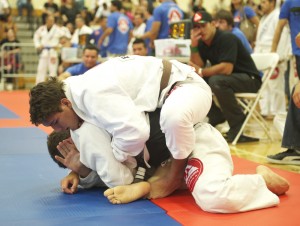Don't Ignore the Basics : Advanced Techniques Too Quickly
We live in an age with never before seen access to information on the internet. And there are few better examples than online bjj techniques. A few clicks and a search and you can be watching the sports elite demonstrating the advanced techniques that they employ at the highest levels of competition.
YouTube is a great resource if used properly.
IF used PROPERLY.
Every academy has some students who arrive at class with a fancy technique that “they just saw on YouTube” and are excited to try. Yet when they get down on the mat, they are a confused tangle of limbs, unable to remember which hand went where!
One of the biggest challenges that bjj instructors face is the student who wants to leap frog the basics, completely bypassing the fundamentals and getting right to the flying triangles and berimbolos.
Read also: 3 Tips For Your First Year of Training
 I had a white belt student ask me some questions about the berimbolo sweep. They explained that they couldn’t successfully get the sweep against some more experienced opponents.
I had a white belt student ask me some questions about the berimbolo sweep. They explained that they couldn’t successfully get the sweep against some more experienced opponents.
Most instructors cringe in these situations!
The student, while displaying interest in learning (a positive thing!) was focusing their attention on the wrong thing for their level of experience. This specific student had next to zero guard passing and poor knowledge of FAR more important elements like maintaining the mount or how to defend their closed guard.
But here, they were asking about an advanced technique for sports bjj competition, and yet lacked the requisite physical skills (the flexibility and ability to roll over the shoulders) to make it work.
I tactfully responded that I was not the person to ask for details on a position that I didn’t use (like Master Carlos Gracie Jr. explained about the popularity of fancy, acrobatic guards in a Gracie Mag article) and that perhaps they should wait in their development to work on that berimbolo position.
 A second student, very new to grappling although having some striking experience, wanted to add some jiu-jitsu to their training. They immediately asked about no-gi classes and from the expression on his face, I could see he was dismissive of training in the kimono.
A second student, very new to grappling although having some striking experience, wanted to add some jiu-jitsu to their training. They immediately asked about no-gi classes and from the expression on his face, I could see he was dismissive of training in the kimono.
Read also: To GI Or Not To GI – That is the question (apologies to Shakespeare)
I explained to him that it was best that he start training in the kimono and could add no-gi training later when he had some level of proficiency in the basic positions on the ground. He skeptically agreed to try a kimono class.
During the warm-up, where fundamental ground exercises are performed, I was shocked that he could not execute the simplest “shrimp” or hip escape movement. He was attempting the first simple forward and rear rolls since he was a child in the playground and it was not a pretty sight!
He had visions of mixed martial arts glory in his imagination, but was unable to execute a shrimp across the mat in the Fundamentals class! I think the student had a new respect for the bjj training in the kimono after a few classes and seeing how little he actually knew.
I would like to make one last point about the basics: when we see a top level black belt submitted in competition, it is rarely by a fancy technique. The submission was more likely from a “basic” technique like a rear collar choke or a triangle – all of which you might learn in a Fundamentals class.
Experimenting with fancy techniques is part of the fun of training and has the benefit of expanding your way of looking at what is possible in the Arte Suave. Go ahead, try them out and have fun.
Just don’t be guilty of ignoring the techniques that you will use every roll during your bjj lifetime!
Gracie Barra Black belt based in Taipei, Taiwan
Twitter: @MarkMullenBJJ

